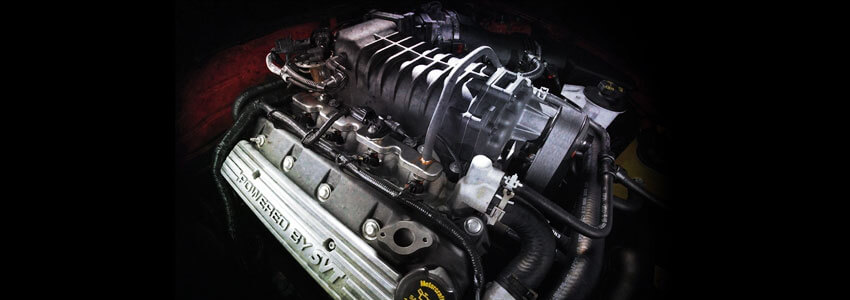
During the mid-2000s, Ford was gearing up to introduce the next-generation Mustang that would
revolutionize the American automotive industry once again. Everyone from young to old was hoping that
this generation of Mustang would pay homage to the original 60s era pony! Leading up to 2005, Ford had
hinted to the Mustang faithful with a concept wholly designed around the original pony itself. Luckily,
Mustang enthusiasts received their wish in January 2005 at the North American International Auto Show in
Detroit, Michigan, where Bill Ford unveiled to the world on the latest pony to be added to the stable.
Unlike the New Edge, the S197 Mustang design was injected with original Mustang DNA, from the fastback
profile,
shark-bite grille, broad rear haunches, and power bulge hood; this pony became the modern interpretation
of the original. As with every generation of Mustang, a Mustang can’t be a Mustang without its beating
heart under the hood. Just like its 60s era counterpart, the original developed serious muscle,
including the Boss 429, Boss 302, Shelby GT350/GT350R, and GT500 427. From 2005-2014, the S197 ruled
the muscle car segment, it emerged with some incredible engine performance including the potent base V6
to the venomous Shelby GT500, every S197 brought muscle to back up its stellar looks to live up to the
family heritage!
Are you looking to know everything about your 2005-2014 Mustang
engine? Below you will find our
comprehensive guide that will give you all the details you’ll need to know about your S197 Mustang
engine!
2005-2010 4.0L 2V SOHC V6
2005-2010 4.6L 3V SOHC Modular V8
2007-2010 5.4L 32V DOHC Supercharged V8 “Iron Block”
"Cyclone" 3.7L Ti-VCT V6
Gen I “Coyote” 5.0L Ti-VCT V8
"Roadrunner” Boss 302 Ti-VCT V8
5.4L Supercharged 32V DOHC V8 “Aluminum Block"
"Trinity” 5.8L Supercharged DOHC 32V V8
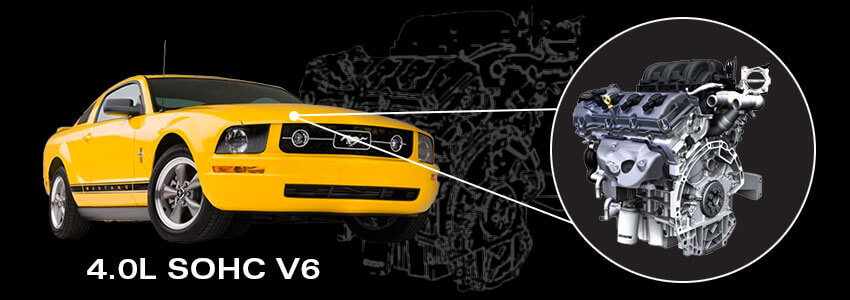
2005-2010 4.0L 2V SOHC V6
Upon launch of the S197, Ford knew it had to step their game up on the base model V6 to compete further
lure in potential buyers. In the New Edge Mustang V6, it came equipped with a 3.8L Essex V6 with only a
measly 145 horsepower at 4,000 RPM and 215 lb/ft of torque at 2,500 RPM. Something was needed to be done
to give entry-level Mustang customers more muscle to go with classic Mustang styling.
To fix this issue, Ford went straight to Mustang engineers to come up with a solution; what they came up
with was a larger displacement V6 in 4.0L, it was the first time in Mustang history a V6 came equipped
with SOHC (Single Over Head Camshaft) technology. What this does is allow for the engine to have more
airflow, create a higher RPM redline, and better low-end torque, this V6 was just what the S197 needed
to create a severe amount of buzz amongst base model Mustang buyers.

Combining with an iron block and aluminum heads, the 4.0L SOHC V6, made a substantial amount of more
power than its predecessor, producing 210 horsepower at 5,250 RPM and 240 lb/ft of torque at 3,250 RPM.
It is easy to see how this engine took the base Mustang to new levels of performance. To transmit power
efficiently, Ford equipped the 4.0L V6 with the choice of either a 5-speed manual or 5-speed automatic
with overdrive. Many enthusiasts would upgrade their V6 Mustang by adding mods such as an exhaust system, cold air
intake, and lowering
springs to add even more muscle to the S197.
You can find the 4.0L SOHC V6 Engine in the following Mustangs:
- 2005-2010 Base Model Mustangs
- 2005-2010 Premium Base Model Mustangs
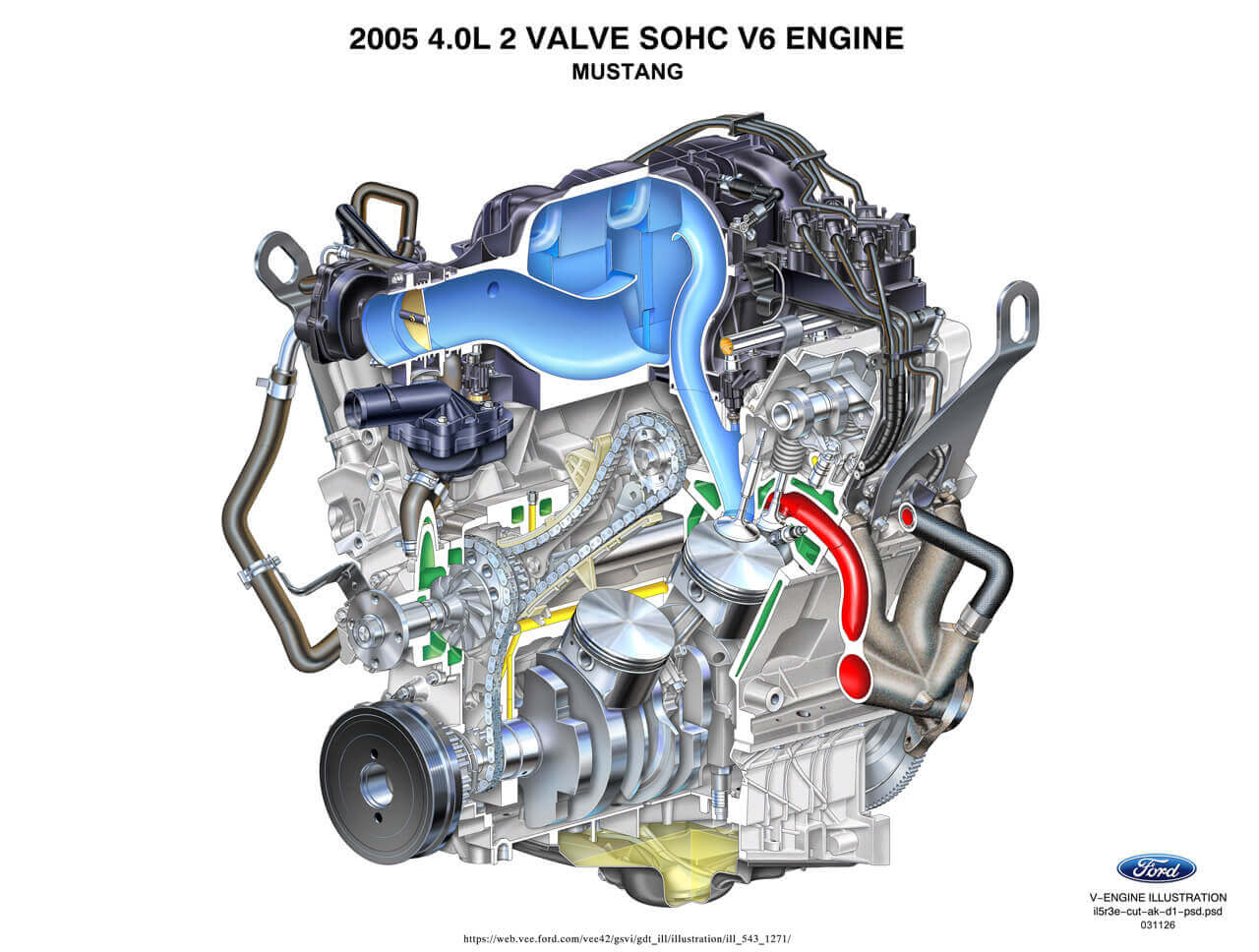
Mustang 4.0L SOHC V6 Specs
| Measurement |
Technical Specification |
| Configuration |
Iron block and Aluminum heads |
| Intake Manifold |
Composite shell-welded with runner pack |
| Exhaust Manifold |
Cast Iron |
| Valvetrain |
SOHC (Single Overhead Camshaft), 2V |
| Valve Diameter/Lift |
Intake 46.0mm & Exhaust 31mm/9.7mm |
| Pistons |
Cast aluminum |
| Connecting Rods |
Forged Steel |
| Ignition |
Distributor-less with coilpack |
| Bore X Stroke |
3.76 X 3.41 in./95.5 X 86.7mm |
| Displacement |
245 Cubic Inches/4.0L |
| Compression Ratio |
9.7:1 |
| Engine Control Sytem |
PCM |
| Horsepower |
210 @ 5,250 RPM |
| Torque |
240 LB/FT of Torque @ 3.500 RPM |
| Recommended Fuel |
87 Octane |
| Fuel Delivery |
Electronic Returnless Sequential Fuel Injection |
| Oil Capacity |
Five Quarts 5W-30 w/Oil Filter 5K Mile Intervals |
| Redline |
6,100 RPM |
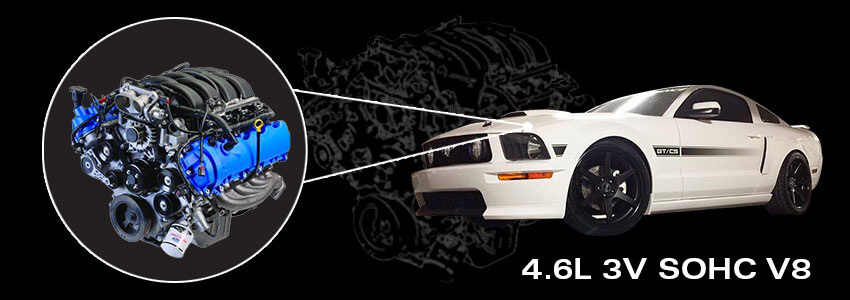
2005-2010 4.6L 3V SOHC Modular V8
To continue the storied legacy of the Mustang GT, Ford engineers knew they would have to push forward
into new boundaries of engine technology. Using the lessons from the 2003-2004 Terminator Cobra, Mustang
engineers went to work to innovate a new cylinder head design that would be more efficient, better
flowing, and create more horsepower. What they ended up with was three valves per cylinder, a single
overhead camshaft, and higher CFM when compared to its outgoing predecessor in the 2V 4.6L V8.
To aid in creating more horsepower and torque, Ford didn't stop at cylinder head technology. Unlike its
predecessors, the 3V 4.6L V8 used a first-ever in Ford history composite shell-welded single-runner
intake manifold with charge motion control valves. It allowed the engine to take in much more air
to help it breathe better, which resulted in creating 300 horsepower at 5,750 RPM and 320 lb/ft of
torque at 4,500 RPM, needless to say, this pony was ready to hurt some feelings.
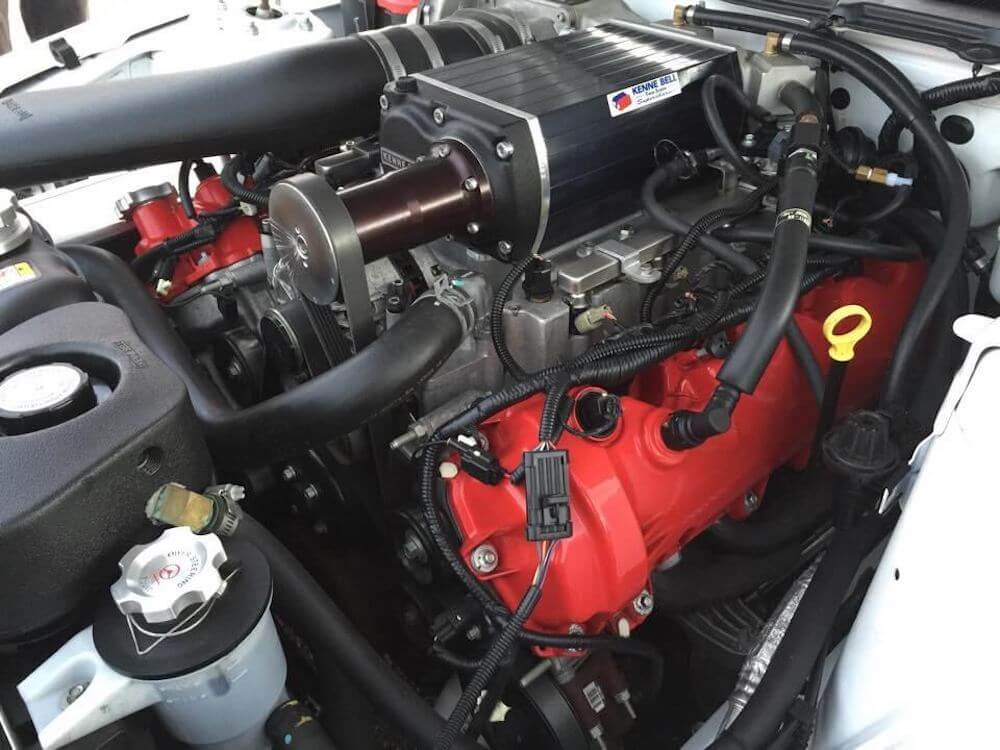
Once released, many enthusiasts caught on quickly to how incredibly easy it is to modify. For example, to
create
even more power, companies like Whipple
Superchargers were the first to offer a selection of twin-screw
superchargers that would increase horsepower to near 500 when combined with a performance tune.
The great thing about the 3V was the solenoid in the intake that truly scared away the competition,
to increase this sound many enthusiasts upgrade to long-tube
headers, off-road
x-pipe, and axle-back
mufflers to create an exhaust note that unleashes freedom!
You can find the 4.6L 3V Modular V8 in the following Mustangs:
- 2005-2010 Mustang GT Base & Premium
- 2007-2009 Mustang GT California Special
- 2008-2009 Mustang Bullitt
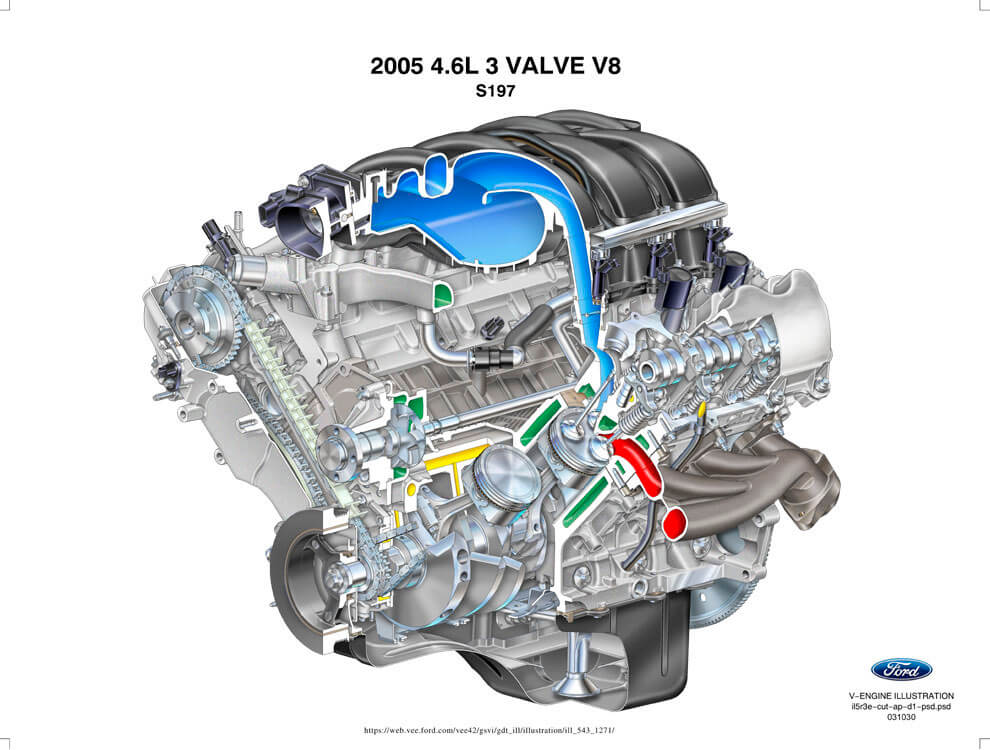
2005-2010 Mustang 4.6L 3V SOHC Modular V8 Specs
| Measurement |
Technical Specification |
| Configuration |
Aluminum block and Cylinder heads |
| Intake Manifold |
Composite shell-welded
Single-runner, charge
motion control valves |
| Exhaust Manifold |
Cast Iron |
| Valvetrain |
SOHC (Single Overhead Camshaft), 3V |
| Valve Diameter/Lift |
Intake: 33.8 mm & Exhaust: 37.5 mm |
| Pistons |
Hypereutectic aluminum |
| Connecting Rods |
Cracked powdered metal
with floating wristpins |
| Ignition |
Coil-on-plug, high-thread-insert
spark plugs |
| Bore X Stroke |
3.55 x 3.54 in. /
90.2 x 90.0 mm |
| Displacement |
281 Cubic Inches/4.6L |
| Compression Ratio |
9.8:1 |
| Engine Control Sytem |
PCM |
| Horsepower |
300 @ 5,750 RPM |
| Torque |
320 LB/FT of Torque @4,500 RPM |
| Recommended Fuel |
87 Octane |
| Fuel Delivery |
Electronic Returnless Sequential Fuel Injection |
| Oil Capacity |
Six Quarts 5W-20 w/Oil Filter 5K Mile Intervals |
| Redline |
6,250 RPM |
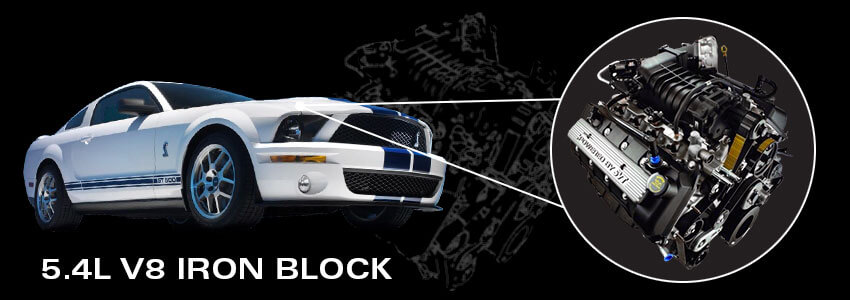
5.4L 4V DOHC Supercharged V8 “Iron Block” V8
Two years after the S197 Mustang launched, a storm was brewing in the skunkworks of SVT (Special Vehicle
Team), creating something so venomous it would scare the pants off any competition that would dare
challenge it.
With the help of the man himself Carroll Shelby, it would be the first time in nearly forty years both
Ford and Shelby teamed
up to recreate an American legend. The Shelby GT500 is the most infamous and legendary model ever to hit
the Mustang lineup, known for its immense horsepower, muscular lines, sleek design, and racing pedigree.
Just like its 1967 GT500 grandfather equipped with a 427 cubic inch V8 pulled straight out the MKII GT40,
the 2007 Shelby GT500 was engineered, designed, and created for one purpose to challenge anything Ford
rivals and competitors could throw at it. Using lessons learned from the haloed Ford GT supercar, Shelby
and Mustang engineers took the same engine technology from the 5.4L Supercharged V8 and injected it
straight into GT500s engine bay. Unlike the 2005-2006 Ford GT, the 2007 GT500 would use a slightly
different approach; it would use an iron block technology versus the Ford GTs all-aluminum block 5.4L
V8. Ford's reasoning behind choosing an iron block versus the aluminum block was purely down to cost as
the Ford GTs engine costs over $33,000 to replace if need be.
Ford knew to make this snake, king of the road again; it would have to inject some cruel venom into it.
Using an Eaton M122 1.9L supercharger, Ford engineers were able to crank out a venomous 500 horsepower
and 480 lb/ft of torque, making it the most potent factory-built production Shelby ever! Transmitting
all this power was a Tremec
TR-6060 6-speed manual transmission into a 3.73 rear end. Zero to sixty
times would register in the mid-four-second range with a top speed of over 150 miles per hour.
2008-2009 Shelby GT500KR
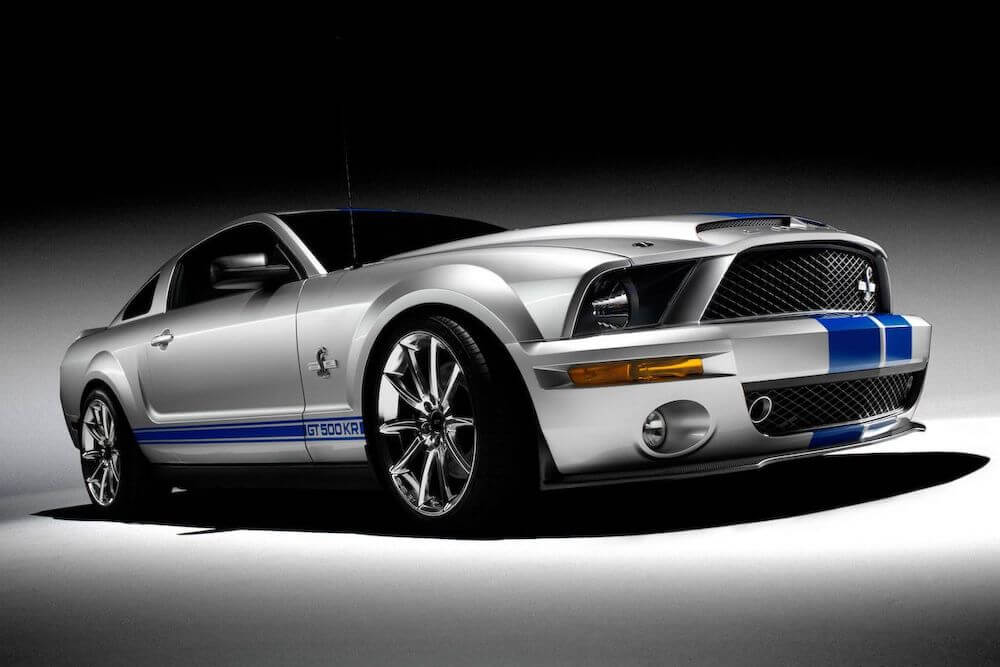
To ensure the GT500 was the absolute king of the road, Ford knew it would have to continue to push the
boundaries of GT500s performance. Leading up to the 2008 model year, Shelby and SVT were at it
again to develop an even more sinister snake to pay homage to the original 1968 "King Of The Road."
Released as a limited production model only, the GT500KR boasts an even more powerful version of the
already venomous 5.4L 32V supercharged V8 in the standard GT500.
SVT engineers took things up a notch by adding the Ford Racing Power Pack, which included a revised
ignition, air/fuel calibration, throatier Ford Racing exhaust, open cold
air intake
system. All of this combined put even more lethal venom into the GT500s engine upping the
horsepower to 540 horsepower at 6,250 RPM and 510 lb/ft of torque at 4,500 RPM. Shelby and Ford clearly
showed the automotive community the king had returned to claim the road once again!
You can find the 5.4L 32V Supercharged "Iron Block" Modular V8 in the following Shelby's:
- 2007-2010 Shelby GT500
- 2008-2009 Shelby GT500KR
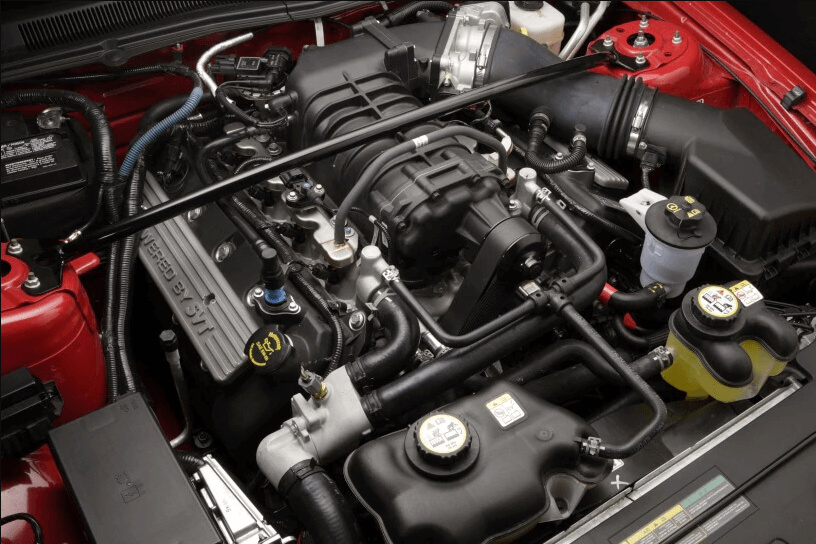
2007-2009 Shelby GT500 Engine Specs
| Measurement |
Technical Specification |
| Configuration |
Iron block and Aluminum heads |
| Intake Manifold |
Intercooled 1.9L Eaton M122 Supercharger |
| Exhaust Manifold |
Cast Iron |
| Valvetrain |
DOHC (Dual Overhead Cam), 32V |
| Pistons |
Forged Aluminum |
| Connecting Rods |
Forged Cracked I-Beam |
| Ignition |
Distributor-less coil on plug design |
| Bore X Stroke |
3.55 in. x 4.17 in. |
| Displacement |
330 Cubic Inches/5.4L |
| Compression Ratio |
11.0:1 |
| Engine Control Sytem |
PCM |
| Horsepower |
500 @ 6,000 RPM |
| Torque |
480 LB/FT of Torque @ 4,500 RPM |
| Recommended Fuel |
93 Octane |
| Fuel Delivery |
Electronic Returnless Sequential Fuel Injection |
| Oil Capacity |
6.4 5W-50 w/Oil Filter 3K Mile Intervals |
| Redline |
6,250 RPM |
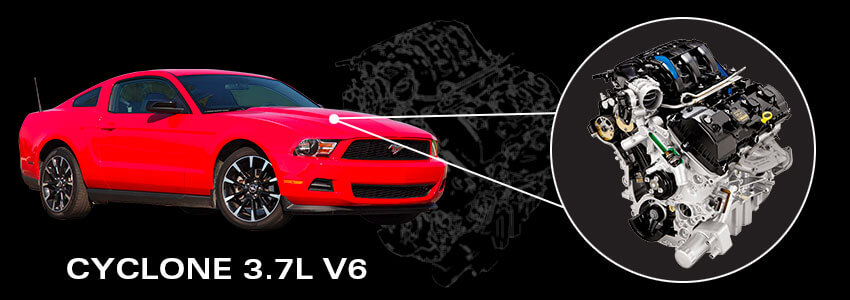
"Cyclone" 3.7L Ti-VCT V6
Now that the S197 Mustang was five years into its generation, Ford knew it was time to bring out the big
guns to compete amongst the base model Camaro and Challenger to have more potential customers. During
this time, Ford was developing leading-edge valvetrain technology that would push new boundaries rarely
ever seen in production model Mustangs. To eradicate the stereotype of owning a V6 Mustang, engineers
used Ti-VCT (Twin Independent Variable Camshaft Timing), which allows the engine to have a more
efficient airflow as it is coming into the intake which will disburse more CFM throughout each intake
valve.
The "Cyclone" V6 was engineered right alongside its big brother "Coyote," so it is not surprising Ford
knew it had to take a significant leap forward in engine design and technology to give customers more
power and options. Every "Cyclone" engine came equipped with four valves per cylinder, a deep breathing
cylinder head, dual overhead camshafts, piston cooling jets, and an all-new coil on plug design for more
powerful efficient combustions at any RPM. These components allowed the engine to produce 305 horsepower
at 6,500 RPM and 285 lb/ft of torque. All this together wholly put a new breed of Mustang within the
stable. Enthusiasts took to the engine very quickly into the aftermarket and saw very quickly the
potential it could provide.
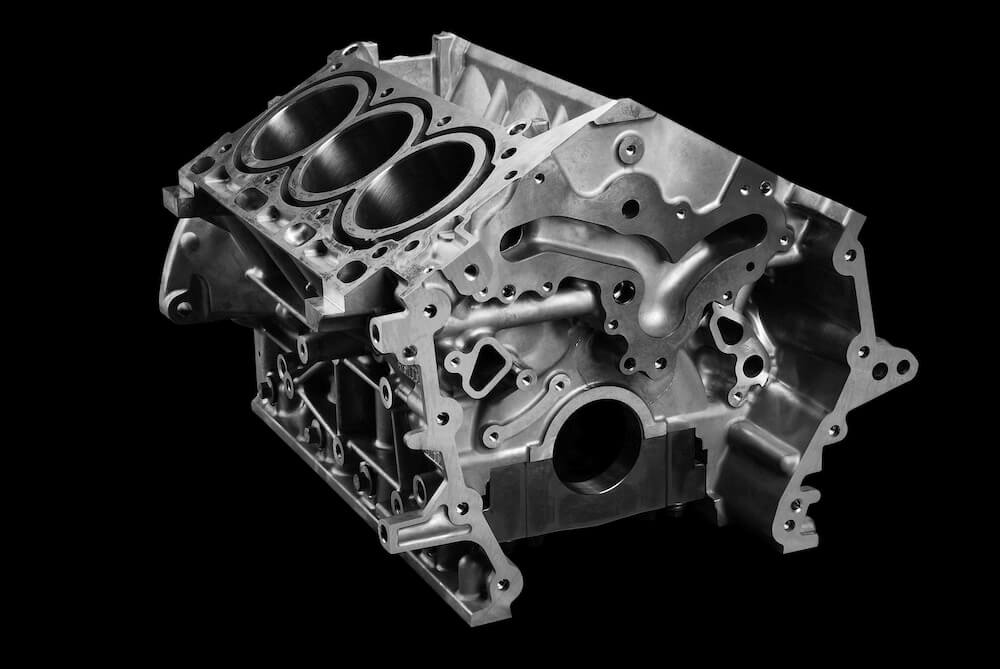
Many enthusiasts choose to upgrade their 3.7L "Cyclone V6 Mustang by adding modifications including a
centrifugal supercharger,
cold air intake, custom tune, exhaust, and lowering springs. All this
combined makes a pony that can take on any of its V8 Mustang siblings and can hurt some serious feelings
along the way. One thing is for sure; the "Cyclone" is the most incredible V6 Mustang engine to ever
come out of Detroit!
You can find the "Cyclone" V6 Engine in the following Mustangs:
- 2011-2014 Base Model Mustangs
- 2011-2014 Premium V6 Mustangs
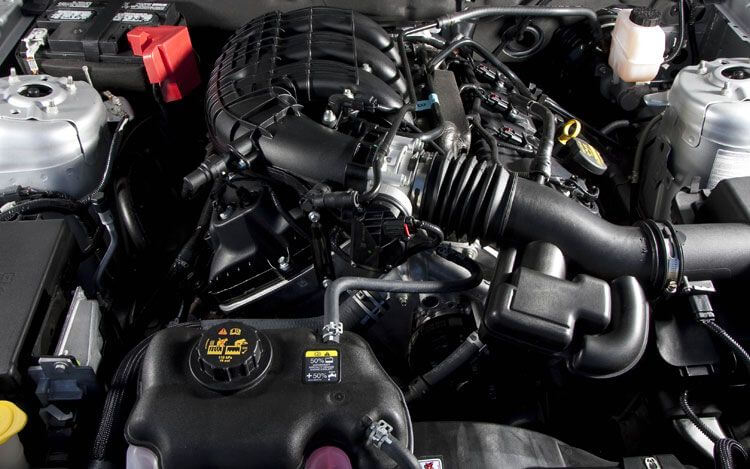
Mustang Cyclone V6 Specs
| Measurement |
Technical Specification |
| Configuration |
Aluminum block and heads |
| Intake Manifold |
Composite shell-welded with runner pack |
| Exhaust Manifold |
Cast Iron |
| Valvetrain |
DOHC (Dual Overhead Cam), 4V Ti-VCT (Twin Independent Variable Camshaft Timing) |
| Valve Diameter/Lift |
Intake 37mm/10mm, Exhaust 31mm/9.7mm |
| Pistons |
Cast aluminum |
| Connecting Rods |
Forged Steel |
| Ignition |
Distributor-less with coil on plug design |
| Bore X Stroke |
3.76 X 3.41 in./95.5 X 86.7mm |
| Displacement |
227 Cubic Inches/3.7L |
| Compression Ratio |
10.5:1 |
| Engine Control Sytem |
PCM |
| Horsepower |
305 @ 6,500 RPM |
| Torque |
285 LB/FT of Torque |
| Recommended Fuel |
87 Octane |
| Fuel Delivery |
Sequential Multiport Electronic Fuel Injection |
| Oil Capacity |
Six Quarts 5W-20 w/Oil Filter 10K Mile Intervals |
| Redline |
6,500 RPM |
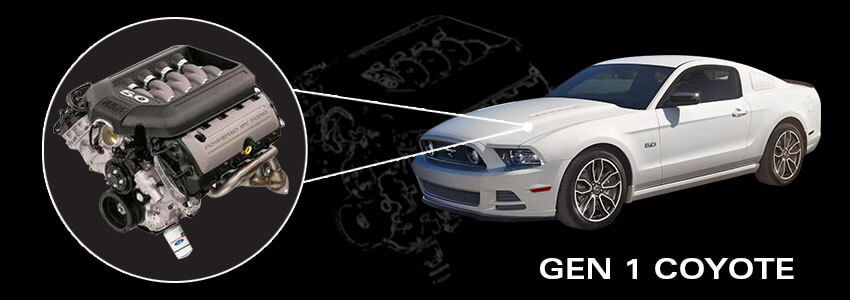
Gen I “Coyote” 5.0L Ti-VCT V8
To keep pushing the Mustang forward into more of an all-around sports car and not just a brute American
muscle, Ford engineers had to come up with innovative ideas to help make this mission possible. In 2011,
the Mustang was getting a refresh from its 2005-2009 counterparts, taking the already bold retro styling
up a notch. To keep the Mustang DNA alive, Ford yet again looks at its storied Mustang history to help
move into the future. During the early 1980s, Mustang engineers were developing an engine that could
outperform against any manufacturer in the marketplace. Through tremendous innovation, focus, and
engineering, they were able to come up with the pushrod 5.0L V8, which revolutionized all Mustang
engines to follow.
Just like the 302 engines of the original 1960s Mustang era, this 5.0 would provide more low-end torque
and power throughout the RPM band without breaking a sweat. Why is this so important you might ask? It
taught Mustang engineers exactly how to evolve this into a modern interpretation of this engine. Using
lessons learned from not only the original 5.0 but other engines like the 5.4L 32V supercharged V8 found
in the GT500, it gave Mustang engineers a clear path on how to develop a new heart to power the
legendary pony!
Through years of hard work and determination, the legend of the 5.0L V8 returned, remastered, and
perfected. Using engine technology such as Ti-VCT (Twin Independent Variable Camshaft Timing) previously
only found in high-end exotics such as Ford's arch-rival Ferrari, the all-new "Coyote" immediately
proved to be an absolute monster. The new 5.0L was bred to deliver 412 horsepower and 390 lb/ft of
torque a perfect harmony of engine technology. It features roller finger followers for razor-sharp valve
action, a deep breathing cylinder head, to burn all of that immense oxygen. A new high energy coil on
plug design was created for powerful efficient combustion. Piston cooling jets kept the "Coyote" 5.0L
engine running correctly to keep performance high and engine life long!
All of this together immediately put the "Coyote" on the map as probably the most significant modern
Mustang engine ever to be developed in its storied history! Since its launch, thousands of Coyote
engines have been produced to give enthusiasts the most exceptional efficiency of
power and performance. To gain even more freedom, many enthusiasts will opt to choose many
modifications, including a supercharger,
long-tube headers, exhaust, upgraded
suspension, and bigger
brakes to make this pony a sinister beast from hell!
You can find the Gen I 5.0L "Coyote" engine in the following Mustangs:
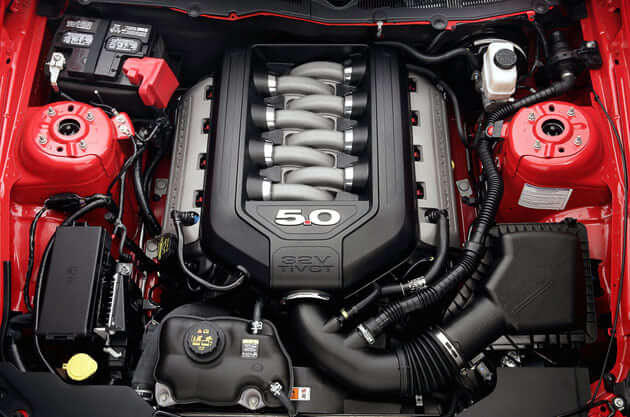
2011-2014 Mustang GT Engine Specs
| Measurement |
Technical Specification |
| Configuration |
Cast aluminum block and heads |
| Intake Manifold |
Composite shell with scroll design and charge motion control valves |
| Exhaust Manifold |
Tubular stainless steel headers |
| Valvetrain |
DOHC, four valves per cylinder, twin independent variable camshaft timing |
| Valve Diameter/Lift |
Intake 37mm/12mm, Exhaust 31mm/12mm |
| Pistons |
Cast aluminum |
| Connecting Rods |
Forged aluminum |
| Ignition |
Distributor-less with coil on plug design |
| Bore X Stroke |
(92.2 mm x 92.7 mm) |
| Displacement |
302 Cubic Inches/5.0L |
| Compression Ratio |
11.0:1 |
| Engine Control Sytem |
PCM |
| Horsepower |
(2011-2012) 412 @ 6,500 RPM
(2013-2014) 420 @ 6,500 RPM
|
| Torque |
390 LB/FT of Torque @ 4,250 RPM |
| Recommended Fuel |
87 Octane |
| Fuel Delivery |
Port Fuel Injection |
| Oil Capacity |
8 quarts 5W-30 with filter (5,000-mile service interval) |
| Redline |
7,000 RPM |
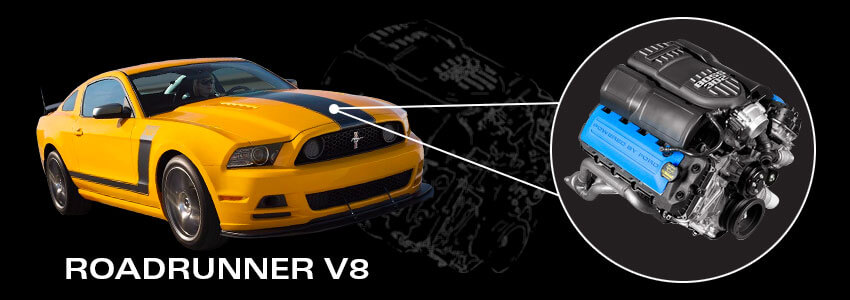
Boss 302 Ti-VCT "Roadrunner" V8
In Mustang history, many models are legendary on and off the track, but no model is more legendary for
track duty than the infamous Boss 302 Mustang! In the late 1960's Ford was at the height of dominating
the decade in all areas of motorsports and racing. To keep dominating into the 1970s, Ford went to work
with its Mustang and racing engineers to come up with a track weapon that would dominate Trans Am
racing. Through many years of track testing, development, and grit, engineers came up with a Mustang
that was like any other. With a philosophy of less weight, higher RPM, and more power, this came to be
what is known as the Boss 302.
When it debuted in 1969, Ford wanted to continue its dominance in sports car racing with the Mustang on
and off the track. As most regulation in racing goes, you must have a homologation of cars built from
the factory to sell to the public to race it. Ford did exactly this, thanks to Dan Gurney and Parnelli
Jones, they took the Boss 302 to many championships in the Trans-Am series, absolutely destroying the
competition along the way including the Mustangs arch-rival Camaro. Unfortunately, the Boss 302 was only
built-in 1969 and 1970. Today its engine it revered as one of the most influential in the entire
automotive history.
It wasn't until over forty years later; Mustang enthusiasts would be able to say the "Boss" is back,
baby! In 2012, Ford pulled the covers off of the newest edition to the Mustang Boss 302 family.
Featuring a high-output version of the Gen I "Coyote" engine, the "Roadrunner" V8 featured new
technology
to live up to its 60s Boss 302 counterpart. Featuring a revised cylinder head with high flow CNC valves
and revised intake, it took the standard Gen I "Coyote" from 412 horsepower to 444 horsepower and 380
lb/ft of torque. For assurance, Mustang engineers provided the 'Roadrunner" with a more stout bottom end
by adding a forged crank-shaft, thick main bearing bulkheads for bottom-end strength, and a lightweight
cylinder block featuring cross-bolted main bearing caps. Ford was out to make sure that everyone in the
automotive industry knew very well that the "Boss" is back.
You can find the Boss 302 “Roadrunner” Ti-VCT V8 engine in the following Mustangs:
- 2012-2013 Mustang Boss 302
- 2012-2013 Mustang Boss 302 Laguna Seca
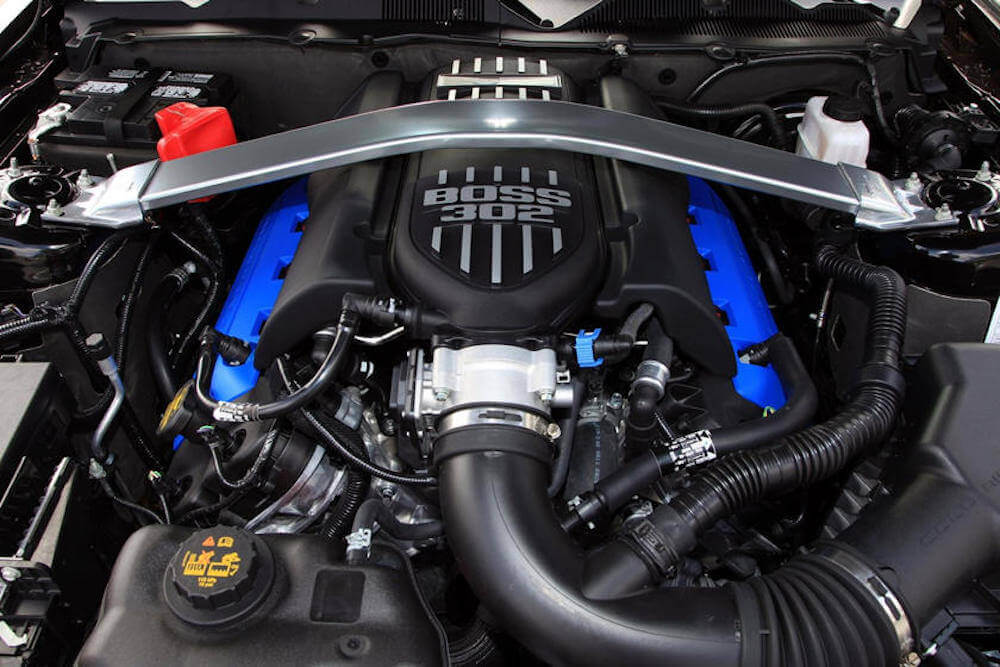
2012-2013 Mustang Boss 302 Engine Specs
| Measurement |
Technical Specification |
| Configuration |
Cast aluminum block and heads |
| Intake Manifold |
Composite Boss 302 Specific with shell-welded and runner pack |
| Exhaust Manifold |
Tubular stainless steel headers |
| Valvetrain |
DOHC, 32 valve (4v per cylinder), high lift exhaust profile, twin independent variable
camshaft timing (Ti-VCT), CNC ported cylinder heads |
| Valve Diameter/Lift |
Intake, 37 mm/12 mm;
Exhaust, 31 mm/11 mm |
| Pistons |
Forged aluminum |
| Connecting Rods |
Forged micro-alloyed steel |
| Ignition |
Distributor-less with coil-on-plug |
| Bore X Stroke |
3.63" x 3.65" (92.2 mm x 92.7 mm) |
| Displacement |
302 Cubic inches/5.0L |
| Compression Ratio |
11.0:1 |
| Engine Control Sytem |
PCM |
| Horsepower |
444 @ 7,300 RPM |
| Torque |
380 ft.-lbs. @ 4,500 rpm |
| Recommended Fuel |
93 Octane |
| Fuel Delivery |
Sequential Mechanical Returnless |
| Oil Capacity |
8.5 quarts 5W-30 full synthetic with filter
(5,000-mile service interval, 3,000 for
heavy use) |
| Redline |
7,500 RPM |
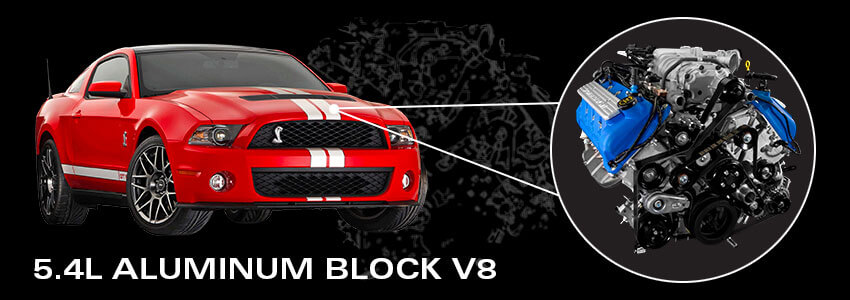
5.4L Supercharged 32V DOHC V8 “Aluminum Block"
With the S197 GT500 a complete success, Ford continued to look forward to how they could inject even more
venom into the already potent Shelby! This second generation of the 5.4L 32V supercharged V8 is even
more poisonous than the outgoing engine, thanks to serious innovation, SVT engineers were able to
combine aluminum technology finally into not just the cylinder heads but also the entire engine block.
It meant the GT500 Could lighten up its front end for better handling and stability through each corner.
In 2011, Ford released the SVT performance package, offering the ability to add engine oil cooler,
stiffer
springs, and better dampers for a more agile snake.
By putting the aluminum block in place of the heavy iron-block 5.4L, SVT engineers were able to build a
much more rigid engine to handle more supercharger boost than ever. An industry first, was Ford's
innovative solution to replace cylinder head gaskets, this gave the cylinder heads, and the
engine a much tighter seal for better compression and performance. This process is called plasma
transfer wire arc; it is a coating that is placed on the walls of the cylinder block where the cylinder
head sits, and the plasma wire arc has transferred a temperature of over 1,000-degrees Fahrenheit.
Combined all together with this fantastic new engine structure and technology, the 5.4L 32 supercharged
Shelby beast can produce a staggering 550 horsepower and 510 lb/ft of torque on just 8 pounds of boost!
To create even more power, enthusiasts will seek to add headers, exhaust, custom tune, and a larger throttle body,
resulting in horsepower numbers well over 600 to the wheels.
You can find the 5.4L 32V Supercharged "Aluminum Block" V8 engine in the following Shelby's:
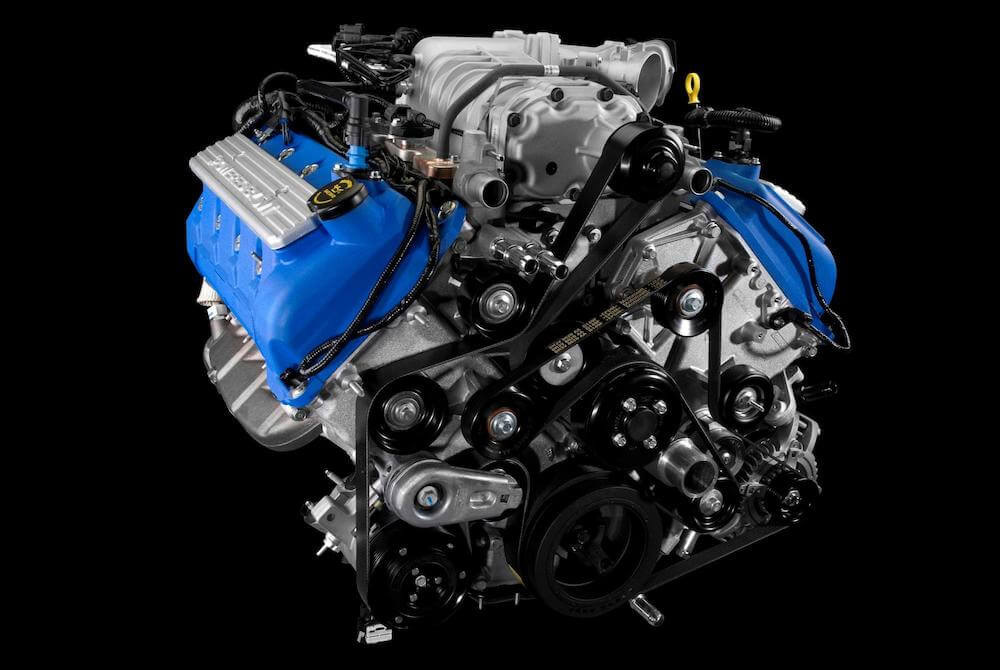
2011-2012 Shelby GT500 Engine Specs
| Measurement |
Technical Specification |
| Configuration |
Cast aluminum block and head with
plasma transfer wire arc cylinder liners |
| Intake Manifold |
Intercooled 2.0 Eaton M112 Supercharger |
| Exhaust Manifold |
Tubular stainless steel headers |
| Valvetrain |
DOHC, 32 valve (4v per cylinder) |
| Pistons |
Forged aluminum |
| Connecting Rods |
Forged Aluminum |
| Ignition |
Distributor-less with coil-on-plug |
| Bore X Stroke |
3.55 in. x 4.17 in. |
| Displacement |
330 Cubic inches/5.4L |
| Compression Ratio |
8.4:1 |
| Engine Control Sytem |
PCM |
| Horsepower |
550 @ 6,200 RPM |
| Torque |
510 ft.-lbs. @ 4,250 rpm |
| Recommended Fuel |
93 Octane |
| Fuel Delivery |
Electronic Returnless Sequential Fuel Injection |
| Oil Capacity |
7 quarts 5W-30 full synthetic with filter
(5,000-mile service interval, 3,000 for
heavy use) |
| Redline |
6,500 RPM |
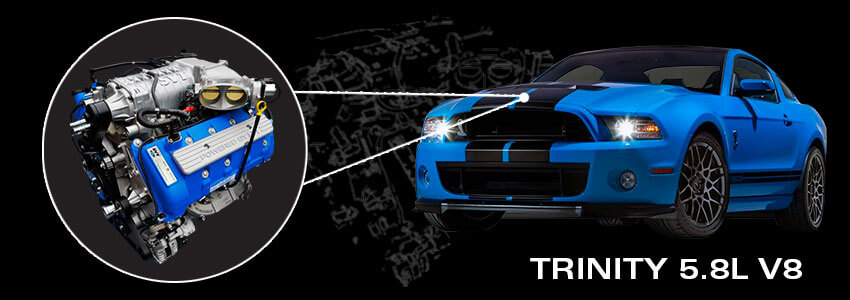
"Trinity” 5.8L Supercharged DOHC 32V V8
Venomous like never before, the 2013-2014 Shelby GT500 is the king of all S197
Mustangs. This vicious beast came equipped with the largest and most powerful engine ever stuffed
inside of America's favorite pony car. With the Mustang and Camaro at full battle with each other,
Mustang and SVT engineers would have to take an absolute no-compromise approach to come out on top once
again. Improving upon the aluminum block architecture from the 2011-2012 GT500, the Trinity is
an entirely different breed of venom. Engineers did smart thinking by boring and stroking out the engine
an extra .4 of a liter displacement to make it 5.8L or 351 cubic inches reminiscent of the original 351
Cleveland and Windsor Mustang engines from the 1960s.
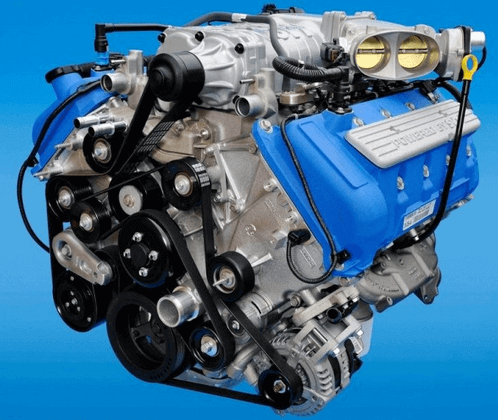
Using the largest supercharger to ever grace on any Cobra or Shelby from the factory, the 2300 2.3L
Eaton TVS supercharger pushed over eleven pounds of boost pushing the horsepower from 550 in the
previous GT500 to an earth-shattering 662 horsepower and 631 lb/ft of torque. At this time, it became
the most powerful mass-produced supercharged engine on the planet. All of this horsepower took the
Shelby
to over 200 miles an hour, for the first time a factory GT500 would reach the two-hundred mph mark.
To cool all of this power and to ensure heat soak wouldn't be an issue, Ford added a plethora of options
within the SVT performance package, including a trans cooler, oil cooler, upgraded radiator, heat
exchanger, and differential cooler to handle the venomous 662 horsepower. To this very day, the
2013-2014 Shelby GT500 is still revered as the most insane Shelby ever to hit dealer showrooms.
You can find the 5.8L 32V Supercharged "Trinity" V8 engine in the following Shelby's:
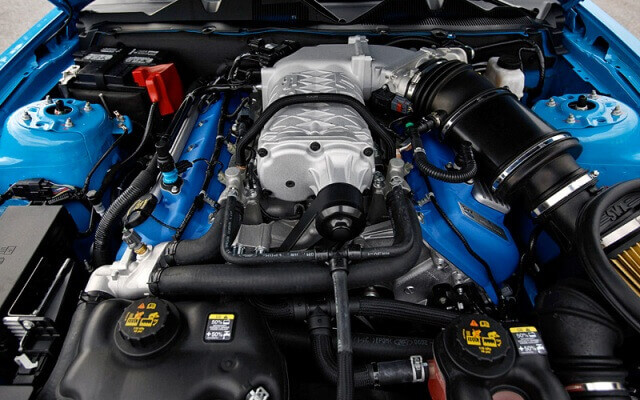
2013-2014 Shelby GT500 Engine Specs
| Measurement |
Technical Specification |
| Configuration |
Cast aluminum block and head with
plasma transfer wire arc cylinder liners |
| Intake Manifold |
Air-To-Water Intercooled 2.3L Eaton TVS 2300 Supercharger |
| Exhaust Manifold |
Tubular stainless steel headers |
| Valvetrain |
DOHC, 32 valve (4v per cylinder) |
| Pistons |
Forged aluminum |
| Connecting Rods |
Forged Forged ALuminum |
| Ignition |
Distributor-less with coil-on-plug |
| Bore X Stroke |
3.68 in. x 4.17 in. |
| Displacement |
351 Cubic inches/5.8L |
| Compression Ratio |
9.0:1 |
| Engine Control Sytem |
PCM |
| Horsepower |
662 @ 6,200 RPM |
| Torque |
631 ft.-lbs. @ 4,000 rpm |
| Recommended Fuel |
93 Octane |
| Fuel Delivery |
Electronic Returnless Sequential Fuel Injection |
| Oil Capacity |
8 quarts 5W-30 full synthetic with filter
(5,000-mile service interval, 3,000 for
heavy use) |
| Redline |
7,000 RPM |
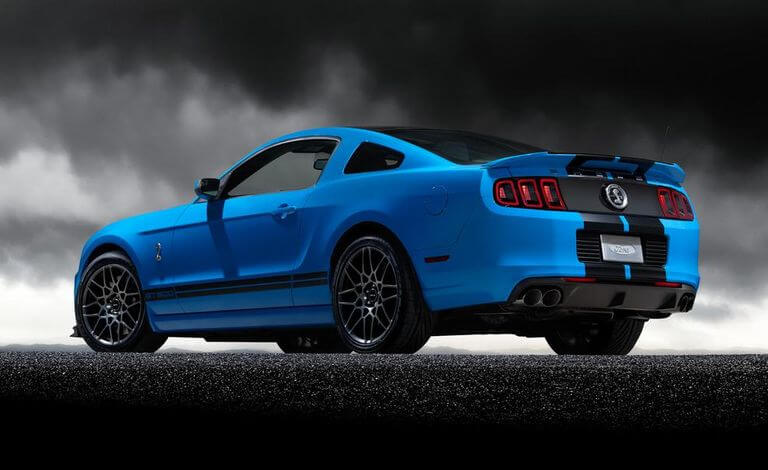

Related Articles
Image Credit: Ford Motor Company, Ford Performance




























